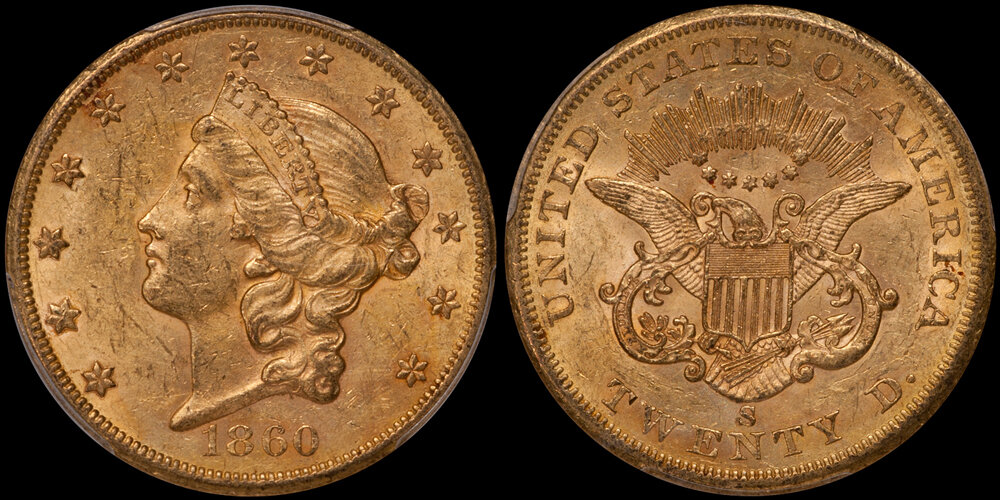1860-S $20.00 PCGS MS62
MINTAGE: 544,950
The 1860-S remains similar to the 1859-S in overall and high-grade rarity. There are a few more choice (MS62-MS63) of the 1860-S, but this remains a scarce date in this range.
STRIKE: As with many of the San Francisco double eagles from this era, the 1860-S is not an especially well struck issue. On the obverse, the hair tends to be weak with little definition noted on the curls or at the top of the head. The bun tends to be weak as well. The stars on the obverse are sharp with many displaying full radial lines. On the reverse, the wing tips are soft even on high grade coins but the rest of the detail is sharp. Many have fine die cracks through the lettering.
SURFACES: The majority of 1860-S double eagles are extensively bagmarked on both the obverse and the reverse. There are some with relatively clean surfaces but these are difficult to locate. I have seen a number which have some minor roughness in the planchet or with mint-made spotting.
LUSTER: The luster is soft and frosty and shows a somewhat grainy texture. The quality of the luster is similar to that seen on the 1859-S and it is superior to that seen on the 1861-S and 1862-S double eagles.
COLORATION: The natural coloration ranges from medium orange-gold to deeper rose-gold to a medium green-gold hue. It has become difficult to locate an 1860-S with nice color as many have been cleaned or dipped.
EYE APPEAL: This date has average eye appeal. Most are softly struck and show numerous abrasions on the surfaces. The luster and color tend to be nice enough on higher grade pieces that the fussy collector can overlook the quality of the strike and the surfaces. A CAC quality example should be locatable but it will command a 15-25% premium over a typical 1860-S.
INTERESTING VARIETIES: All have a medium S mintmark. There are no significant varieties.
PROOFS: No proofs were struck.
HOARDS: There were a total of 63 examples in the S.S. Republic. These were mostly grade AU55 to AU58 by NGC. There were 18 pieces in the S.S. Brother Jonathan treasure. These were mostly in the EF40 to AU50 range. A significant number of 1860-S double eagles from the Fairmont Hoard have sold since 2018. The single best as of the end of 2023 is a PCGS/CAC which sold for $36,000 as Stacks Bowers 4/2022: 5391.
BUYING TIPS: The rarity of this issue in properly graded MS60 and higher is underestimated as many collectors mistakenly believe that the 1860-S is a shipwreck date. Any Uncirculated example, especially with natural color and better than average surfaces, is rare.
AUCTION RECORD: The current auction record for this date is $36,000 which was set by Stacks Bowers 4/2022: 5037, graded MS62 by PCGS/CAC.
FINEST KNOWN: The finest known is a PCGS/CAC MS64 owned by DL Hansen and ex Dr. William Crawford. A PCGS MS63 is likely the second best and it sold for $29,900 as Heritage 1/2012: 5037. Around seven to nine properly graded MS62’s are currently known.
RARITY:
TOTAL KNOWN: 1500-2000+
BY GRADE:
Very Fine: 200-205
Extremely Fine: 800-995
About Uncirculated: 450-725
Uncirculated: 50-75
PCGS Number: 8931
POPULATION FIGURES: As of the end of 2023, PCGS had graded 13 in MS60, 21 in MS61, 12 in MS62 and one each in MS63 and MS64 for a total of 48 in Uncirculated. NGC had graded seven in MS60, 15 in MS61, one in MS61+, five in MS62, and one in MS62+ for a total of 29 in Uncirculated. This includes three in Uncirculated from the S.S. Republic. These figures are inflated, especially in MS61.
CAC has given approval to two in MS60, three each in MS61 and MS62 and a sole MS64 for a total of nine in Uncirculated.
PERFORMANCE SINCE 2002: In the current market, a choice About Uncirculated example of this date (equivalent to AU55) is worth $2,800-3,200. The same coin in 2002 was valued at $2,000-2,500. In the current market, an average quality Uncirculated example of this date (equivalent to MS61) is worth $9,000-11,000. The same coin was worth $4,500-5,500 in 2002.
COMMENTS: The 1860-S double eagle is a scarce and underrated date in higher grades. I believe I overstated the number known in Uncirculated when I wrote the first edition of this book in 2002. There are currently just two pieces which have been graded higher than MS62 (and one of these, the PCGS MS63, has a large stain on the obverse) with probably no more than a dozen properly graded pieces known in MS62. An outstanding example of this date can still be purchased for less than $15,000, and I believe that this is an excellent comparative value within the context of the Type One series.
LAST UPDATED: 12/29/2023

